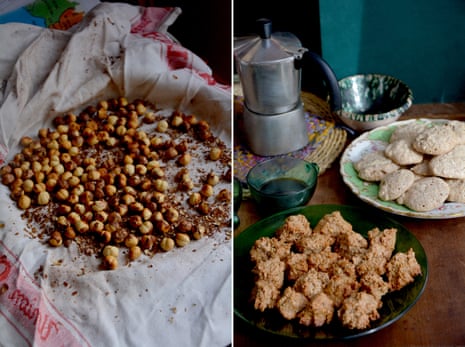Brutti ma buoni, or “ugly but good”, is the name of this week’s recipe: hazelnut and egg white biscuits. Like many edible things, their origins are disputed; it seems likely that the biscuits originated in Prato, a city and commune in Tuscany where they are also known as mandorlati di San Clemente. Wherever they originated, brutti ma buoni have migrated all over Italy and are now found in pretty much every bakery next to the soft almond biscuits, the biscuits made with wine (to dip in wine) and wisp-thin cat’s tongues.
Quite how ugly the biscuits are depends on the bakery, and the beholder. Our local makes brutti ma buoni – and there is no getting around this – that look like neat mounds of poo. I am amused every time I see them, which is every day. However, this unfortunate association does not make them ugly to me. Quite the opposite: I find the tray of rough-hewn mounds delightful, like a soft almond amaretti, only made more interesting with the dense butteriness of hazelnuts and an almost toffee chew.
Brutti ma buoni are made of just three ingredients: hazelnuts, sugar and egg whites, the proportion of each depending on the recipe. Having tried half a dozen, I found one I am happy with, not least because it is a recipe with two possible outcomes. Both, though, start with ground hazelnuts.
You can buy ground hazelnuts, but the natural oils start dissipating as soon as they are ground, so the flavour fades in the bag. If you have time, it is worth buying whole, unblanched ones and roasting them, which brings out the flavour, then grinding them yourself. While some recipes claim that true brutti ma buoni must have a double cooking, others don’t. For the latter, let the soft mixture sit for five minutes, then plop teaspoons of it on to a baking tray lined with parchment. Bake at 130C (110C fan)/gas ½ for 45 minutes. This makes 20 or so pale, meringue-like brutti ma buoni that have a brittle shell and a slightly chewy middle.
The second option is to scrape the mixture into a pan and cook it again over a medium flame for five to seven minutes, stirring continuously. It will thicken like porridge and darken. Let it sit for five minutes, so it can tighten even more, then use a spoon to arrange the mixture in small, walnut-sized mounds on a baking tray lined with parchment. As before, bake at 130C (110C fan)/gas ½ for 45 minutes; the double cooking changes the nature of the dough and produces a dark, craggy outside – not so much crisp but firm – and a chewy, almost toffee-like middle.
My preference is for the second option: the rough hewn version that justifies the second step. That said, if I was going to make them to go with a soft pudding, such as chocolate mousse, syllabub or lemon pudding, then the first option, the pale and delicate meringue brutti ma buoni with their gentle crumble, make for a beautiful partner.
Brutti ma buoni (“ugly but good” hazelnut biscuits)
Prep 10 min
Cook 1 hr 30 min
Makes 20-25
200g hazelnuts
110g icing sugar
80g egg white (the whites of two medium-sized eggs)
1 pinch salt
40g caster sugar
Put the hazelnuts on a baking tray then into an oven set to 170C (150C fan)/gas 3 for 10-15 minutes, or until lightly coloured and the skins blistered. Wrap the nuts in a kitchen towel, leave for one minute then, making sure the towel is wrapped tightly, rub vigorously to remove the loose skins – don’t worry about skins that don’t come off. Leave to cool.
Grind or pound the nuts into a coarse rubble, set a third aside, then continue grinding the rest into a fine flour. Put the coarse and finely ground nuts into a bowl with the icing sugar.
Whisk the egg whites and a pinch of salt until frothy, add the caster sugar and whisk until stiff, sleek peaks form. Fold the egg whites into the nuts and sugar.
There are two options for baking. The first is to let the mixture rest for five minutes, then plop teaspoons of it onto a baking tray lined with parchment, leaving space between each one as they will spread. Bake at 130C (110C fan)/gas ½ for 45 minutes, then leave to cool before lifting from the tin.
The second option is to scrape the mixture into a pan and cook over a medium flame, stirring continuously, for five to seven minutes, in which time the mixture will thicken and darken from beige to a deep golden brown. Leave to rest for five minutes.
Plop teaspoons of the mixture onto a baking tray lined with parchment. Bake at 130C (110C fan)/gas ½ for 45 minutes. Allow to cool before lifting from the tin.

Comments (…)
Sign in or create your Guardian account to join the discussion